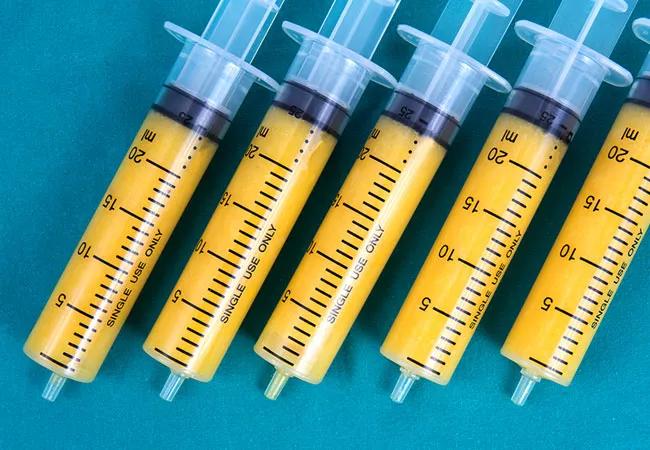Study reveals imaging not always necessary

Fat grafting has become an important tool in breast reconstruction, improving outcomes to such an extent that it is has become a standard practice. Along with the increasing popularity of fat grafting as part of breast reconstruction, a trend toward increased imaging and biopsies for palpable masses may be emerging. While some masses may indeed warrant further studies to test for malignancy, entertaining the possibility of cancer recurrence while undergoing invasive screening procedures may cause stress and anxiety in patients.
Advertisement
Cleveland Clinic is a non-profit academic medical center. Advertising on our site helps support our mission. We do not endorse non-Cleveland Clinic products or services. Policy
Some degree of palpable changes in fat grafted areas may be unavoidable, and is something that may not be communicated to patients or other clinicians who manage their follow-up after breast reconstruction. However, imaging and biopsies ordered in these situations tend to reveal benign changes, according to a recent Cleveland Clinic study of the incidence, type, timing and diagnostic yield of unexpected postsurgical imaging in women with implant-based breast reconstruction.
“As reconstructive surgeons perform fat grafting more frequently as part of reconstruction after mastectomy, we noticed what appeared to be an increasing tendency for clinicians to obtain imaging or biopsy during short and long term follow-up for cancer,” states Graham Schwarz, MD, a plastic surgeon with Cleveland Clinic’s Dermatology and Plastic Surgery Institute and senior author of the study. “We suspected that some of these tests, especially those ordered soon after surgery, may be potentially unnecessary and might increase patients’ anxiety, healthcare resource utilization and cost. We wanted to explore the timing, frequency and results of this testing, and which providers were ordering the tests, in order to develop provider and patient education focusing on what to expect following breast reconstruction with fat grafting.”
Researchers reviewed the records of 166 patients (204 breasts) who underwent fat grafting as part of implant-based breast reconstruction. The most common diagnoses were invasive breast cancer (106 breasts) and ductal carcinoma in situ (52 breasts). The patients underwent a mean of 1.3 fat grafting episodes, and the average amount of fat transferred was 107.5 cc per breast, per episode. Of the group, 26.5% underwent at least one imaging study and 7.8% had at least one biopsy. Twenty-five women (15%) had mammography, 42 women (25.3) had at ultrasound imaging and three (1.8%) had magnetic resonance imaging (MRI).
Advertisement
Fat-related changes, such as fat necrosis or the development of oil cysts, were the most common findings. Although some of the imaging results were assessed as suspicious for malignancy, it is important to note that, in all these cases, biopsy of the suspicious masses was benign.
Imaging was ordered by multiple providers, including oncologists, medical/surgical breast specialists and primary care physicians. Plastic surgeons ordered imaging and biopsies with less frequency. Overall, the reconstructive teams were involved in diagnostic decision-making one-third of the time.
“One key takeaway from this study is that we have the opportunity to educate patients and providers alike about what to expect after fat grafting performed during the breast reconstruction process. Collaborating with our breast radiology colleagues, we developed an algorithmic approach to managing patients who present with a palpable mass following fat grafting procedures. Our next steps include developing a patient education plan that conveys information about safety and common postoperative physical findings, and encourages patients, when possible, to consult their reconstructive surgeons before undergoing additional imaging or biopsies. We also learned that reconstructive surgeons can help their clinical colleagues by providing more focused documentation about the anatomic region of fat grafting and where in the breast palpable nodules arise following the procedure,” Dr. Schwarz says.
“Overall, fat grafting in breast reconstruction after mastectomy is a procedure that significantly enhances reconstructive results. Data from multiple studies support the fact that it does not promote recurrence of breast cancer within the first years after surgery,” Dr. Schwarz continues. “Vigilance on the part of the patients and physicians is key to detecting recurrence. There were certainly multiple instances in which there was suspicion and additional testing was needed. However, if we can identify in which situations these tests will be of low yield, we can reduce the inconvenience and emotional burden of additional testing for breast cancer patients.”
Advertisement
Advertisement

Researchers uncover profound differences in the mechanism of action between different PD-L1 checkpoint inhibitors

A multi-pronged strategy for tackling cancer access problems

Early results show patients experiencing deep and complete response

Inclusion of genomic profiling and risk factors recommended for treatment planning

Collaborative research effort underscores the urgent need for effective second-line therapies in this rare, aggressive cancer

Largest study to date comparing direct-acting oral anticoagulants to low-molecular-weight heparin

Treatment assigned FDA review date in June 2025

Pembrolizumab does not improve outcomes, but immunotherapy may still offer benefit